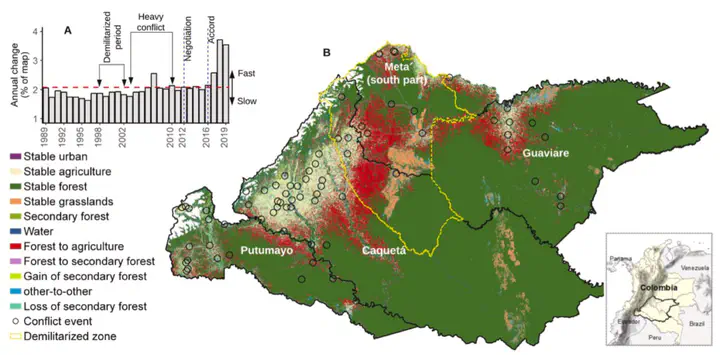No peace for the forest: Rapid, widespread land changes in the Andes-Amazon region following the Colombian civil war
 Image credit: Paulo Murillo
Image credit: Paulo Murillo
Abstract
Negative environmental impacts of violent conflict have been observed worldwide. Whether or not active global conflicts are declining in number remains hotly debated, the number of countries entering post-conflict periods is on the rise, and the impact of this transition on land cover changes remains poorly understood. In Colombia, though large-scale armed conflict has concluded, the post-conflict period represents an ongoing threat to forest conservation, putting at risk commitments to meet global conservation goals and even those stipulated in the peace accord. This paper aims to assess land cover change associated with the Colombian conflict in the Andes- Amazon region between 1988 and 2019. First, we use the Landsat archive to map land cover and characterize the spatial patterns of change at the regional level. Second, to empirically identify the effect of conflict on land cover change, we employ a difference-in-difference approach using local conflict events data. During conflict (1988–2011), land cover in the Andes-Amazon remained relatively stable, however during the post-conflict period (2012–2019), the conversion from forest to agriculture increased by 40%. We find that forest cover surrounding conflict events (1 km radius) decreased significantly, on average by ~ 19% during conflict, which accelerated to ~ 30% in the post-conflict period. Similarly, agriculture expansion is most substantial during the post-conflict period, but exclusively in municipalities with population below the 50th percentile. Landscape metrics show that in peripheral municipalities (<50th), agriculture occurs in clumped distributions during the conflict period. Meanwhile, during the post-conflict period, this expansion happens more quickly, with signifi- cantly greater agricultural patch sizes than during the conflict period. We conclude that a slow implementation of conservation governance, the emergence of illegal land markets, and illicit land uses (i.e., coca and illegal cattle ranching) may accelerate land cover change in the coming years.